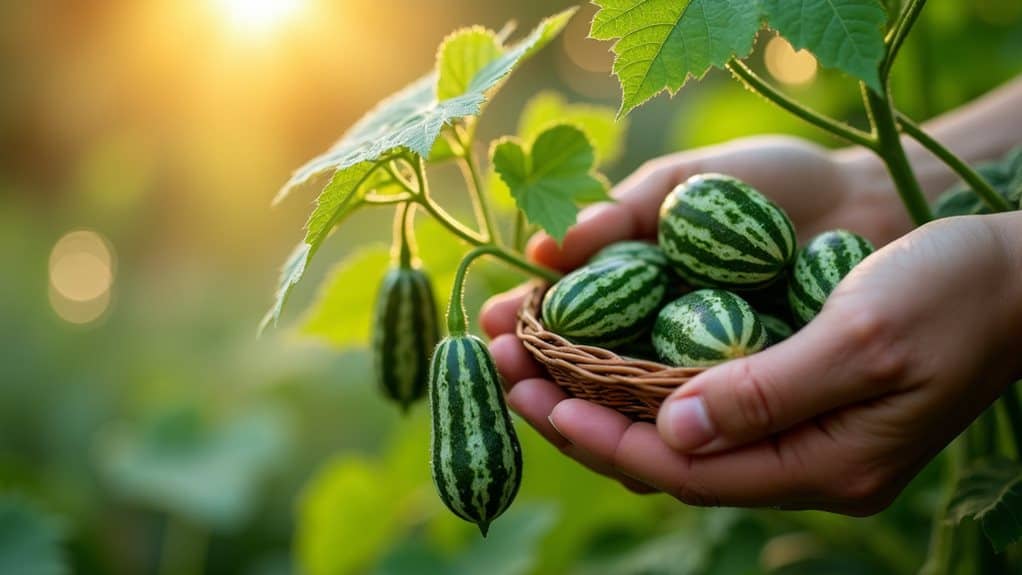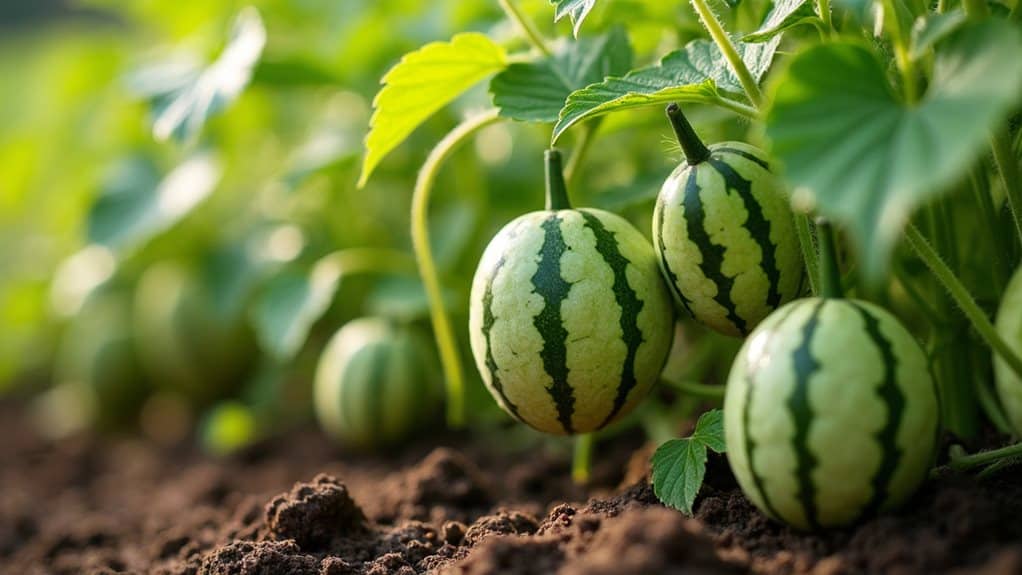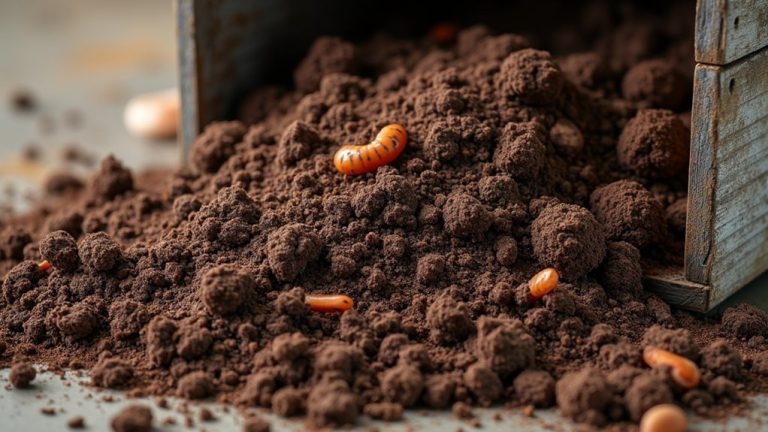Growing Cucamelons: A Fun and Easy Garden Treat
You’ll absolutely love growing cucamelons—these adorable grape-sized fruits that look like tiny watermelons but taste like tangy cucumbers with a pleasing crunch! Start seeds indoors 6-8 weeks before your last frost, keeping them cozy at 70-80°F, then transplant to a sunny spot with sturdy trellises since these vigorous climbers reach 5-6 feet tall. With proper spacing, regular watering, and a bit of patience, you’ll be harvesting these conversation-starting treats in just 65-75 days, and there’s so much more to uncover about maximizing your cucamelon success.
Quick Guide
- Start cucamelon seeds indoors 6-8 weeks before last frost, maintaining 70-80°F temperatures for germination within 7-10 days.
- Plant in full sun locations with well-draining soil and sturdy 5-6 foot trellises to support climbing vines.
- Space plants 12-16 inches apart and water at soil level while providing regular maintenance and vine support.
- Harvest grape-sized fruits after 65-75 days when firm and bright green by twisting them off the vine.
- These tangy cucumber-flavored fruits are packed with antioxidants and serve as unique conversation starters in any garden.
What Are Cucamelons and Why Grow Them

While most gardeners are content growing the same old tomatoes and peppers year after year, you’re probably looking for something that’ll make your neighbors do a double-take when they peek over the fence – and that’s exactly where cucamelons come in!
These grape-sized fruits look like tiny watermelons but taste like tangy cucumbers, making them perfect conversation starters. Beyond their novelty appeal, cucamelons are packed with powerful antioxidants like lycopene and beta-carotene that support your health while you enjoy their unique flavor. Additionally, growing cucamelons can enhance soil health by improving nutrient availability and promoting beneficial microorganisms in your garden.
Starting Seeds and Germination Requirements
Now that you’re convinced these little green gems deserve a spot in your garden, let’s get those seeds started so you can be munching on homegrown cucamelons by midsummer!
Start your seeds indoors 6-8 weeks before your last frost date, planting them ¼ inch deep in 4-inch pots with well-draining soil, and keep them toasty at 70-80°F for best germination. Your patience will be rewarded when germination occurs in 7-10 days with proper warmth and moisture. Additionally, ensuring healthy soil practices will contribute to robust plant growth and maximize your yield.
Choosing the Perfect Growing Location

Once your seedlings have sprouted and are ready for their permanent home, you’ll want to scout out the absolute best spot in your garden where these climbing cuties can truly thrive and produce those adorable grape-sized fruits you’re dreaming about. Look for full sun, well-drained soil, and space for sturdy trellises. Additionally, consider the importance of proper ventilation to ensure healthy growth and prevent any potential issues with pests or diseases.
Planting and Spacing Your Cucamelons
Now that you’ve picked the perfect spot for your cucamelons, it’s time to get those tiny seeds in the ground and give them the space they need to flourish!
You’ll want to hone your skills in seed sowing, figure out the ideal spacing between plants, and decide whether you’re starting indoors like a cautious planner or heading straight outside like a garden explorer.
Trust me, getting these fundamentals right from the start will save you headaches later and set you up for a harvest that’ll make your neighbors wonder what those adorable little watermelon-lookalikes are all about!
Seed Sowing Techniques
Getting your cucamelon seeds off to a strong start requires the right containers and soil preparation, which honestly makes all the difference between seedlings that thrive and ones that struggle from day one.
You’ll want peat pots or cell packs with drainage holes, quality seed-starting mix, and planting holes just ¼” to ½” deep—trust me, deeper delays germination considerably.
Optimal Plant Spacing
While proper seed sowing sets the foundation for healthy cucamelons, the spacing decisions you make during transplanting will determine whether your vines flourish or fight each other for resources throughout the growing season.
You’ll want to give each plant about 12-16 inches of breathing room, which perfectly balances their need for nutrients while allowing their friendly vines to naturally intertwine.
Indoor Vs Outdoor
Whether you’re dreaming of a cozy indoor garden that’ll keep producing through winter or planning an outdoor cucamelon paradise that’ll make your neighbors jealous, the choice between indoor and outdoor growing dramatically changes your planting strategy, spacing decisions, and daily care routine.
Indoor containers need heat mats and grow lights, while outdoor vines love natural sunshine and sprawling freedom.
Supporting and Training the Vines
Since cucamelon vines possess an enthusiastic climbing nature that’ll remind you of enthusiastic kids scrambling up jungle gyms at summer camp, you’ll want to provide them with sturdy vertical supports that reach at least 5 to 6 feet high to accommodate their adventurous spirit.
Trellises work perfectly, and you’ll need to gently guide those enthusiastic tendrils upward regularly.
Watering, Feeding, and Ongoing Care

Now that you’ve got those adorable little vines climbing happily up their supports, it’s time to master the art of keeping them healthy and productive through proper watering, feeding, and daily maintenance – think of yourself as a cucamelon camp counselor making sure everyone’s got enough water, snacks, and clean clothes!
Just like how you’d pack extra water bottles for a hot summer camping trip, your cucamelons need consistent moisture and regular feeding to produce those grape-sized treasures that’ll make your gardening friends absolutely jealous.
You’ll uncover that maintaining these vigorous climbers involves a perfect balance of hydration, nutrition, and gentle grooming that’ll keep them churning out crispy little gems all season long.
Trust me, once you nail this routine, you’ll feel like the most accomplished outdoor explorer in your neighborhood!
Proper Watering Techniques
Most cucamelon growers find that mastering the watering game is like uncovering the perfect balance between keeping your plants happy and avoiding the dreaded “soggy sock syndrome” that nobody wants in their garden!
You’ll want to water directly at the soil line, skip the overhead sprinkling, and aim for that sweet spot of moist-but-not-waterlogged soil.
Fertilizing for Growth
While you’ve got the watering routine down pat, your cucamelon plants are going to need some nutritional TLC to really pump out those adorable little fruits that look like tiny watermelons!
Start by mixing aged compost into your soil before planting, then feed them balanced fertilizer every few weeks until flowering begins—after that, switch to high-potassium fertilizer for maximum fruit production!
Essential Plant Maintenance
Three core maintenance practices will keep your cucamelon vines thriving like happy little campers throughout the growing season.
Trust me, once you get into the rhythm of caring for these quirky plants, you’ll find they’re surprisingly forgiving compared to their fussier cucumber cousins!
Keep soil consistently moist, remove yellowing leaves weekly, and support those climbing vines.
Harvesting Your Cucamelon Crop

After about 65 to 75 days of nurturing your cucamelon plants, you’ll finally get to experience that magical moment when these adorable, grape-sized fruits are ready for harvest – and trust me, there’s nothing quite like spotting those first tiny watermelon-lookalikes dangling from your vines!
Simply twist them off when they’re firm, bright green, and perfectly grape-sized.
Saving Seeds and Overwintering Tips
Since you’ve just experienced the thrill of harvesting those adorable little watermelon-wannabes, you’re probably wondering how to keep this incredible gardening adventure going for years to come – and I’ve got some fantastic news for you!
You can easily save seeds by fermenting them in water for three days, then drying completely before storing in labeled paper envelopes.
Wrapping Up
You’ve got everything you need to grow these adorable little grape-sized cucumbers that’ll make your neighbors do double-takes! From my experience, cucamelons are practically foolproof once you get them started, and they’re perfect conversation starters at summer barbecues. Don’t you think there’s something magical about growing exotic fruits that taste like lime-kissed cucumbers? Trust me, once you bite into that first crisp cucamelon, you’ll be planning next year’s bigger patch already!







